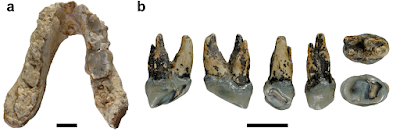Is Graecopithecus a hominin?
 |
| Graecopithecus, from Fuss and colleagues 2017, figure 1. |
I've gotten a few questions about this Graecopithecus, so I guess I should weigh in with some kind of opinion. The problem is that there isn't much to have an opinion on.
The Graecopithecus fossils in question are a jaw from Greece and a tooth from Bulgaria, shown above. The fossils have been known for decades, but the new study from Jochen Fuss and colleagues applies micro-CT to the teeth and attempts to draw from that a classification of the fossil. As far as I can tell (and remember I'm not a paleoanthropologist), this is a pretty neat way to get information out of a pretty uninformative fossil. Based on the shape of the roots of the teeth, Fuss and colleagues propose that Graecopithecus may have been or definitely was a hominin. Their certainty on this point varies in different locations in the paper, suggesting that reviewers made them tone it down.
As you can see in the photo above, the jaw is kind of a mess. The teeth are extremely worn, so all the useful information that paleoanthropologists usually get from the crowns is gone. The roots of the teeth are therefore the only information left for trying to figure out what sort of ape Graecopithecus was. The authors claim that the roots of the fourth premolar are more similar to humans than to living great apes or apes known from the fossil record. Ergo, it's a hominin.
As I mentioned above, in different parts of the paper, the authors' certainty regarding their hominin identification changes. In the abstract, they say "it shows features that point to a possible phylogenetic affinity with hominins." Nicely cautious. In the description of the specimens, they conclude, "G. freybergi is a hominid in the size range of female chimpanzees based on dentognathic size." At the end of the paper, they conclude, "the dental root attributes of Graecopithecus suggest hominin affinities, such that its hominin status cannot be excluded." Again, very cautious and appropriate. The final sentence then goes back to being certain, "it seems likely that the Eastern Mediterranean needs to be considered as just as likely a place of hominine diversification and hominin origins as tropical Africa."
I'm not one to dismiss evidence simply because it originates from an evolutionist or it's inconvenient to my view of the world, but I am prone to be skeptical of evidence that is slim. There's a lot that goes into being a hominin, based on the hominins that we know about. The chief characteristic that currently unites all hominins is the ability to walk upright on two legs. That involves a host of anatomical features that can be seen throughout the skeleton. This is the root of a tooth. I don't doubt that it's interesting and possibly very informative. But is it informative enough to say that Graecopithecus is definitely a hominin? Maybe. Maybe not.
I'd love to see more micro-CT work done on other Miocene apes (and there are a lot of Miocene apes). I'd like to know how different Graecopithecus really is from other Miocene apes. I'd also really like to see more of the skeleton of Graecopithecus, because even if I grant that the shape of the tooth of Graecopithecus is only found in hominins, it's still possible that Graecopithecus is the one exception where that shape occurs in something that isn't a hominin.
My verdict: I'm no expert on hominin teeth, but call me a skeptic on this one.
Don't take my word for it, though. Read the original research report right here:
Fuss et al. 2017. Potential hominin affinities of Graecopithecus from the Late Miocene of Europe. PLoS ONE 12(5): e0177127.
Feedback? Email me at toddcharleswood [at] gmail [dot] com. If you enjoyed this article, please consider a contribution to Core Academy of Science. Thank you.